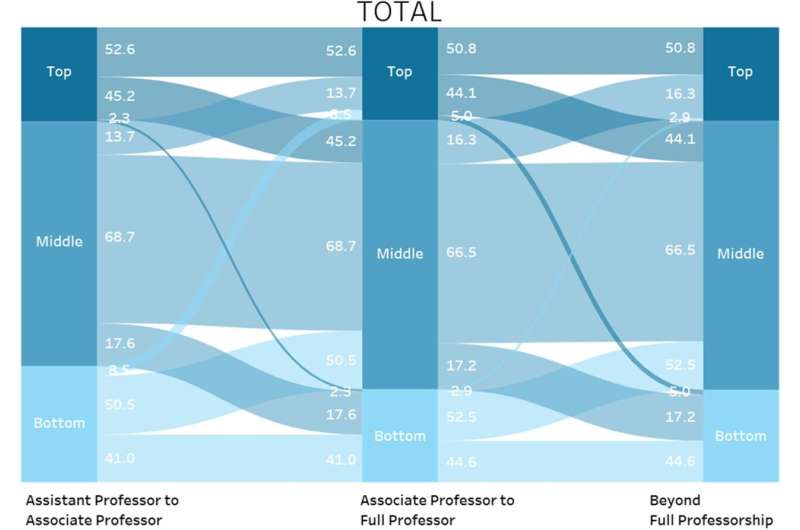Study on persistence in research productivity produces implications for hiring policies
Do scientists change over 40 years of their academic careers? Can they be radically different in terms of their productivity, for instance, can low performers become top performers? Or perhaps top performers will always be top performers, and bottom performers will always be bottom performers?
The idea was tested in a national study, “Once Highly Productive, Forever Highly Productive?” published in Higher Education. Anecdotal knowledge was verified with solid data, including Big Data.
This longitudinal study explores persistence in research productivity over time (40 years). The authors examine the trajectories of the academic careers of 2,326 current Polish full professors in 14 STEMM disciplines, studying their lifetime biographical histories and publication histories.
Every full professor is compared in terms of productivity classes (top, middle, bottom) with their peers at earlier career stages.
The results show that membership in top productivity classes is to a large extent determined by being in these classes earlier—and much earlier. Half of the current top productive full professors belonged to top productivity classes throughout their academic careers. Half of the top productive assistant professors continued as top productive associate professors, and half of the top productive associate professors continued as top productive full professors (52.6% and 50.8%).
Top-to-bottom and bottom-to-top transitions in productivity classes occurred just marginally. Only 4.3% of scientists enjoyed a radical top-to-bottom or bottom-to-top transitions in their careers.
The combination of biographical and demographic data with raw Scopus publication data from the past 50 years (N=1 million) made it possible to assign all full professors retrospective to different productivity, promotion age, and promotion speed classes.
In logistic regression models, two powerful predictors of belonging to the top productivity class for full professors were being highly productive as assistant professors and as associate professors (increasing the odds by 180% and 360%). Neither gender nor age (biological or academic) emerged as statistically significant.
The findings have important implications for hiring policies: hiring high- and low-productivity scientists may have long-standing consequences for institutions and national science systems as academic scientists usually remain in the system for decades.
More information:
Marek Kwiek et al, Once highly productive, forever highly productive? Full professors’ research productivity from a longitudinal perspective, Higher Education (2023). DOI: 10.1007/s10734-023-01022-y
Provided by
Adam Mickiewicz University
Citation:
Study on persistence in research productivity produces implications for hiring policies (2023, March 27)
retrieved 27 March 2023
from https://phys.org/news/2023-03-persistence-productivity-implications-hiring-policies.html
This document is subject to copyright. Apart from any fair dealing for the purpose of private study or research, no
part may be reproduced without the written permission. The content is provided for information purposes only.

Do scientists change over 40 years of their academic careers? Can they be radically different in terms of their productivity, for instance, can low performers become top performers? Or perhaps top performers will always be top performers, and bottom performers will always be bottom performers?
The idea was tested in a national study, “Once Highly Productive, Forever Highly Productive?” published in Higher Education. Anecdotal knowledge was verified with solid data, including Big Data.
This longitudinal study explores persistence in research productivity over time (40 years). The authors examine the trajectories of the academic careers of 2,326 current Polish full professors in 14 STEMM disciplines, studying their lifetime biographical histories and publication histories.
Every full professor is compared in terms of productivity classes (top, middle, bottom) with their peers at earlier career stages.
The results show that membership in top productivity classes is to a large extent determined by being in these classes earlier—and much earlier. Half of the current top productive full professors belonged to top productivity classes throughout their academic careers. Half of the top productive assistant professors continued as top productive associate professors, and half of the top productive associate professors continued as top productive full professors (52.6% and 50.8%).
Top-to-bottom and bottom-to-top transitions in productivity classes occurred just marginally. Only 4.3% of scientists enjoyed a radical top-to-bottom or bottom-to-top transitions in their careers.
The combination of biographical and demographic data with raw Scopus publication data from the past 50 years (N=1 million) made it possible to assign all full professors retrospective to different productivity, promotion age, and promotion speed classes.
In logistic regression models, two powerful predictors of belonging to the top productivity class for full professors were being highly productive as assistant professors and as associate professors (increasing the odds by 180% and 360%). Neither gender nor age (biological or academic) emerged as statistically significant.
The findings have important implications for hiring policies: hiring high- and low-productivity scientists may have long-standing consequences for institutions and national science systems as academic scientists usually remain in the system for decades.
More information:
Marek Kwiek et al, Once highly productive, forever highly productive? Full professors’ research productivity from a longitudinal perspective, Higher Education (2023). DOI: 10.1007/s10734-023-01022-y
Provided by
Adam Mickiewicz University
Citation:
Study on persistence in research productivity produces implications for hiring policies (2023, March 27)
retrieved 27 March 2023
from https://phys.org/news/2023-03-persistence-productivity-implications-hiring-policies.html
This document is subject to copyright. Apart from any fair dealing for the purpose of private study or research, no
part may be reproduced without the written permission. The content is provided for information purposes only.
